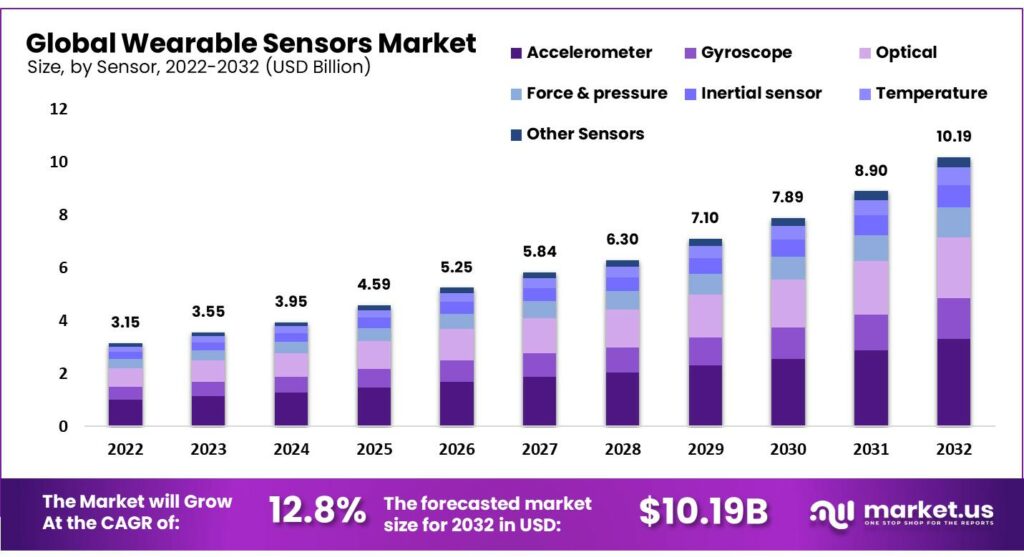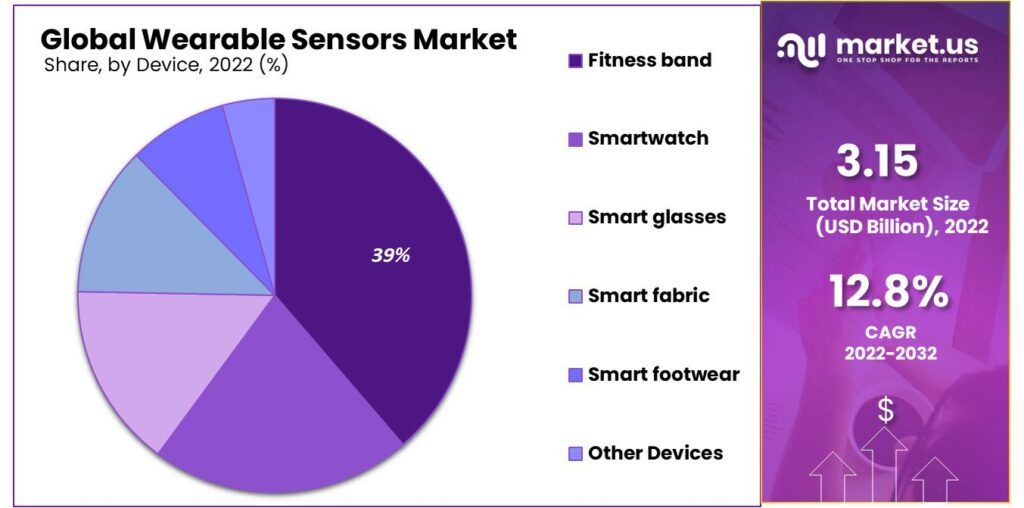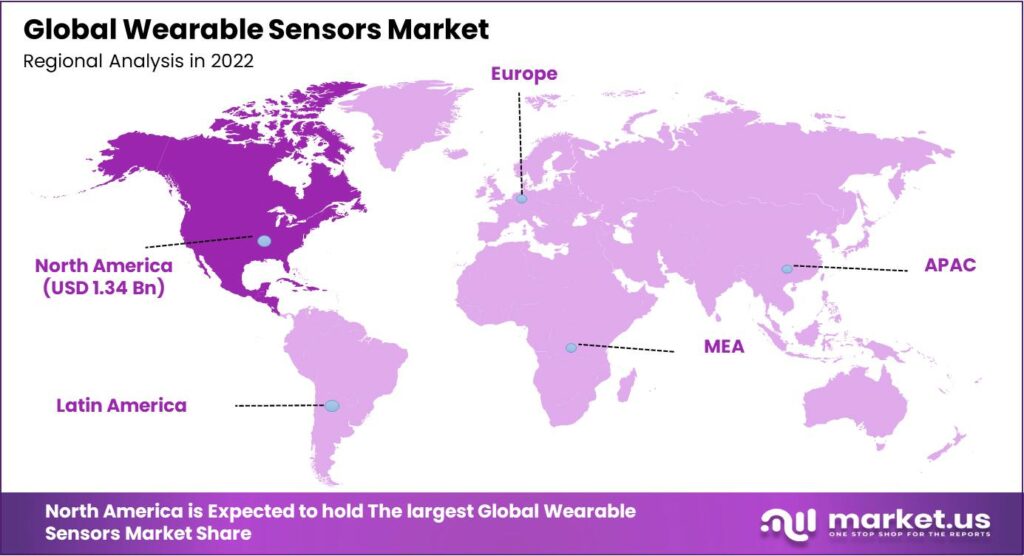New York, Jan. 29, 2024 (GLOBE NEWSWIRE) -- According to Market.us, The Wearable Sensors market size is expected to be worth around USD 10.19 Billion by 2033 from USD 3.55 Billion in 2023, growing at a CAGR of 12.8% during the forecast period from 2023 to 2032.
Wearable Sensors are a critical component in the rapidly expanding field of wearable technology, revolutionizing how individuals monitor and manage health, fitness, and a range of other activities. These sensors are embedded in devices like smartwatches, fitness bands, smart clothing, and medical devices. They are designed to collect data on various parameters such as heart rate, body temperature, movement, sleep patterns, and even biochemical markers.
The Wearable Sensors Market is experiencing significant growth, driven by the increasing popularity of health and fitness tracking devices among consumers and the growing emphasis on remote health monitoring. This market encapsulates a diverse range of sensor types including accelerometers, gyroscopes, magnetometers, heart rate sensors, temperature sensors, and even emerging categories like stretch sensors and smart fabrics.
Want to Access the Statistical Data and Graphs, Request PDF Sample @ https://market.us/report/wearable-sensors-market/request-sample/

Important Revelation:
- The global Wearable Sensors market is anticipated to reach a substantial value of USD 10.19 billion by the year 2033. This growth is expected to occur steadily, with a Compound Annual Growth Rate (CAGR) of 12.8% during the forecast period.
- Accelerometers are the dominant sensor type in the market, holding a significant market share of 32.4%, with a CAGR of 12.7%. Optical sensors are also experiencing rapid growth with a CAGR of 13.4%.
- Among wearable devices, fitness bands accounted for the largest revenue share in 2022, at 38.7%. However, smartwatches are projected to be the fastest-growing segment with a CAGR of 14.4%.
- The consumer segment holds the most significant share in the wearable sensors market, accounting for 44.5% of the market. It is also the fastest-growing segment with a CAGR of 13.7%.
- North America accounted for the largest revenue share in 2022, at 42.7%, owing to its high adoption rate of advanced technologies and a well-established healthcare infrastructure. Asia-Pacific is expected to be the fastest-growing region with a CAGR of 13.8%, driven by a large population with increasing disposable income.
Buy Now this Premium Report to Grow your Business: https://market.us/purchase-report/?report_id=27749
Analyst's Perspective
The Wearable Sensors Market is positioned for substantial growth, underpinned by several driving factors and opportunities, particularly in the realms of health, fitness, and industrial applications. The primary driving forces include the escalating demand for health and fitness monitoring devices among consumers, and the rising need for remote patient monitoring in healthcare. The integration of advanced technologies in wearable sensors, such as improved data accuracy, miniaturization, and extended battery life, further propels this market forward.
The opportunities in this market are diverse and expanding. In the healthcare sector, wearable sensors offer substantial potential for continuous patient monitoring, especially for chronic diseases, enhancing both preventive care and long-term treatment management. The fitness and wellness industry also presents significant opportunities, as consumers increasingly seek devices that provide detailed insights into their health and activity levels.
For new entrants, the Wearable Sensors Market offers considerable opportunities. The market is still evolving, with ample scope for innovation in sensor technology and new use cases. Startups and new companies can capitalize on niche segments, such as specialized health monitoring devices, or target emerging applications in different industries. Additionally, partnerships with established players in the healthcare, fitness, and technology sectors can provide new entrants with valuable channels for market entry and expansion.
Factors Affecting the Growth of the Global Wearable Sensors Market
- Increasing Demand for Fitness and Wellness Applications: Wearable sensors are widely used in fitness and wellness applications, such as activity tracking, heart rate monitoring, sleep tracking, and calorie counting. The increasing awareness of personal health and fitness, coupled with the growing popularity of wearable devices, has led to a surge in demand for wearable sensors in this segment.
- Advancements in Sensor Technologies: Continuous advancements in sensor technologies, such as miniaturization, improved accuracy, and enhanced functionality, have contributed to the growth of the wearable sensors market. These advancements have made it possible to integrate multiple sensors into compact wearable devices, enabling a wide range of applications and functionalities.
- Growing Adoption of Wearable Devices in Healthcare: Wearable sensors have gained significant traction in the healthcare industry. They are utilized for remote patient monitoring, disease management, fall detection, medication adherence, and other healthcare applications. The increasing focus on preventive healthcare and the need for continuous monitoring of vital signs are driving the adoption of wearable sensors in the healthcare sector.
- Increasing Application Areas: Wearable sensors are finding applications beyond fitness and healthcare. They are being utilized in industries such as sports and athletics, military and defense, manufacturing, and entertainment. The versatility of wearable sensors in capturing and transmitting data in real-time has opened up new opportunities for their adoption in various sectors.
- Technological Integration and Connectivity: Wearable sensors are often integrated with other technologies such as wireless connectivity, cloud computing, and artificial intelligence. This integration allows for seamless data transfer, analysis, and storage, enhancing the overall functionality and user experience of wearable devices. The integration of wearable sensors with smartphones and other smart devices has further boosted their adoption.
For a better understanding, refer to this sample report, which includes corresponding tables and figures@ https://market.us/report/wearable-sensors-market/request-sample/
Competitive Landscape
The competitive landscape of the market has also been examined in this report. Some of the major players include:
- Robert Bosch GmbH
- STMicroelectronics N.V.
- Texas Instruments Incorporated
- Infineon Technologies AG
- Analog Devices Inc.
- InvenSense Inc. (TDK Corporation)
- Infineon Technologies AG
- InvenSense Inc.
- Other Key Players
Recent Developments
- In May 2023, STMicroelectronics (Switzerland) unveiled its inaugural MEMS pressure sensors, featuring high accuracy and superior environmental robustness. These sensors are well-suited for applications in gas and water-metering equipment, weather monitoring, air conditioning, and home appliances.
- Knowles Electronics (US) unveiled the Trio of Sisonic MEMS microphones designed for ear and wearable solutions in April 2023. These innovative SiSonic microphones aim to elevate the audio standard, catering to the demands of today's on-the-go lifestyle.
Scope of the Report
| Report Attributes | Details |
| Market Value (2023) | USD 3.55 Billion |
| Forecast Revenue 2033 | USD 10.19 Billion |
| CAGR (2023 to 2032) | 12.8% |
| North America Revenue Share | 42.7% |
| Base Year | 2023 |
| Historic Period | 2018 to 2022 |
| Forecast Year | 2024 to 2033 |
Report Segmentation
Sensor Analysis
The Accelerometer segment held a dominant market position in the Wearable Sensors market, capturing more than a 32.4% share. This prominence is primarily due to the versatility and fundamental role accelerometers play in a wide range of wearable devices. Accelerometers are crucial for tracking motion and orientation, making them essential in fitness trackers, smartwatches, and sports wearables. They are used to measure steps, detect movement patterns, and analyze physical activities, aligning perfectly with the growing trend of health and fitness monitoring among consumers.
Additionally, accelerometers are integral in the development of advanced features in wearables, such as fall detection and activity recognition, which are especially important in healthcare applications for elderly care and chronic disease management. The ability of these sensors to provide valuable data for health and fitness applications explains their significant market share.
Device Analysis
The Fitness Band segment held a dominant market position in the Wearable Sensors market, capturing more than a 38.7% share.
This segment's strong market position can be attributed to several factors. Fitness bands, also known as activity trackers, have gained immense popularity among health-conscious consumers due to their ability to monitor and track various fitness metrics, including steps taken, calories burned, heart rate, sleep patterns, and distance traveled. These devices provide individuals with real-time feedback and insights into their fitness levels, enabling them to set goals, track progress, and make informed decisions about their health and wellness.
The dominance of the fitness band segment can also be attributed to its affordability and ease of use compared to other wearable devices. Fitness bands are often compact, lightweight, and designed to be worn on the wrist, making them comfortable and convenient for everyday use. The user-friendly interfaces and intuitive mobile applications associated with fitness bands have contributed to their widespread adoption.

Vertical Analysis
The Consumer segment held a dominant market position in the Wearable Sensors market, capturing more than a 44.5% share. This segment's strong market position can be attributed to several factors.
The consumer segment encompasses individuals who utilize wearable sensors for personal and recreational purposes, such as fitness tracking, wellness monitoring, and entertainment. The widespread adoption of wearable devices among consumers, including smartwatches, fitness bands, and smart glasses, has been a key driver behind the dominance of this segment.
One of the primary reasons for the consumer segment's dominance is the increasing focus on personal health and fitness. Consumers are becoming more health-conscious and are actively seeking ways to monitor and improve their physical well-being. Wearable sensors provide them with real-time data and insights into various health metrics, including heart rate, sleep patterns, calorie expenditure, and activity levels. This information enables individuals to track their progress, set fitness goals, and make informed decisions about their lifestyle choices.
Buy this Complete Business Report@ https://market.us/purchase-report/?report_id=27749
Key Market Segments
Based on Sensor
- Accelerometer
- Gyroscope
- Optical
- Force & pressure
- Inertial sensor
- Temperature
- Other Sensors
Based on Device
- Smartwatch
- Fitness band
- Smart glasses
- Smart fabric
- Smart footwear
- Other Devices
Based on Vertical
- Consumer
- Defense
- Healthcare
- Industrial
- Other Verticals
Drivers: The increasing trend toward smaller, smarter, and cheaper sensors
Wearable sensors have become increasingly popular due to the growing demand for smaller, smarter, and more affordable devices. Technological advancements have led to the development of compact and efficient sensors that can be seamlessly integrated into wearable devices, enabling a wide range of applications in industries such as healthcare, sports and fitness, and consumer electronics.
Restraint: Lack of common standards and interoperability issues
One of the major challenges facing the wearable sensors market is the absence of common standards and interoperability between different devices and platforms. This lack of standardization can hinder the seamless integration and communication between wearable devices and other systems, limiting the potential for widespread adoption and hindering the interoperability of data collected across different devices.
Opportunity: Increasing number of connected devices
The rise of the Internet of Things (IoT) has created a significant opportunity for the wearable sensors market. As the number of connected devices continues to grow, wearable sensors can play a crucial role in collecting and transmitting data from these devices to enable advanced analytics and insights. This interconnectedness offers immense potential for applications in healthcare monitoring, smart homes, industrial automation, and other sectors.
Challenge: Device protection and thermal consideration
Wearable devices are exposed to various environmental conditions and physical stresses, making device protection and thermal management significant challenges. Ensuring the durability and reliability of wearable sensors in harsh environments, along with managing heat dissipation, are critical considerations. Overheating can lead to performance degradation and potential safety risks, necessitating the development of innovative solutions to address these challenges effectively.
Don't miss out on business opportunities | Get sample pages at https://market.us/report/wearable-sensors-market/request-sample/
Regional Analysis
North America held a dominant market position in the wearable sensors market, capturing more than a 42.7% share. This substantial market share can be attributed to several key factors, including advanced technological infrastructure, a high level of consumer awareness, and significant investments in healthcare and fitness technologies. The United States and Canada, as leading contributors in this region, have seen an upsurge in the adoption of wearable devices, driven by the increasing prevalence of chronic diseases and a growing emphasis on personal health monitoring.
In Europe, the wearable sensors market is characterized by steady growth, supported by rising health consciousness among consumers and ongoing research and development in wearable technology. European Union regulations and policies promoting digital health technologies have further catalyzed this market's expansion. Germany, the United Kingdom, and France are notable contributors, with their focus on integrating advanced technologies in healthcare systems.

By Geography
- North America
- The US
- Canada
- Europe
- Germany
- France
- The UK
- Spain
- Italy
- Russia
- Netherland
- Rest of Europe
- APAC
- China
- Japan
- South Korea
- India
- Australia
- New Zealand
- Singapore
- Thailand
- Vietnam
- Rest of APAC
- Latin America
- Brazil
- Mexico
- Rest of Latin America
- Middle East & Africa
- South Africa
- Saudi Arabia
- UAE
- Rest of MEA
Explore Extensive Ongoing Coverage on Technology and Media Reports Domain:
- Edge AI market Expected to Attain a Valuation of USD 143.6 Billion by 2032, with a CAGR of 25.9% during forecast period.
- Farm management software market was USD 2.60 bn in 2022. It is estimated to reach USD 8.94 bn in 2032, CAGR of 13.5% from 2023-32.
- Payment Processing Solutions Market size is expected to be worth around USD 198 Billion by 2032, growing at a CAGR of 12.00%.
- AI Training Dataset Market was valued at USD 1.9 Billion in 2022. This market is estimated to register the highest CAGR of 20.5%.
- API Management Market will reach USD 49.9 Billion in 2032, from USD 4.5 Billion in 2022; at a CAGR of 28% during forecast period.
- Game-Based Learning Market is expected to reach USD 77.4 bn between 2023 and 2032; register the highest CAGR of 21.6%.
- Data Center Construction Market size is projected to reach a valuation of USD 453.5 Billion by 2033 at a CAGR of 6.7%.
- Cybersecurity Insurance Market is set to reach USD 62.7 billion by 2032, predicted to expand at a CAGR of 18.8% till 2032.
- Digital identity solutions market was valued at US$ 28 Bn and is projected to reach US$ 131.6 Bn by 2032, with the highest CAGR of 17.2%.
- Edge Data Center Market is projected to reach USD 51.0 billion by 2032, growing at a CAGR of 19.9% from 2022 to 2032.
- Retail Analytics Market size is expected to be worth around USD 39.6 Bn by 2032 from USD 5.7 Bn in 2022, growing at a CAGR of 22%.
- By 2032, the Satellite Communication market is anticipated to grow at a 9.4% CAGR, having reached USD 182.7 billion.
- Electric Vehicle (EV) Charging Infrastructure Market is Set to Attain USD 224.8 Billion by 2032, Expands Steadily at a CAGR of 27.5%.
About Us
Market.US (Powered by Prudour Pvt Ltd) specializes in in-depth market research and analysis and has been proving its mettle as a consulting and customized market research company, apart from being a much sought-after syndicated market research report-providing firm. Market.US provides customization to suit any specific or unique requirement and tailor-makes reports as per request. We go beyond boundaries to take analytics, analysis, study, and outlook to newer heights and broader horizons.
Follow Us On LinkedIn Facebook Twitter
Our Blog:
